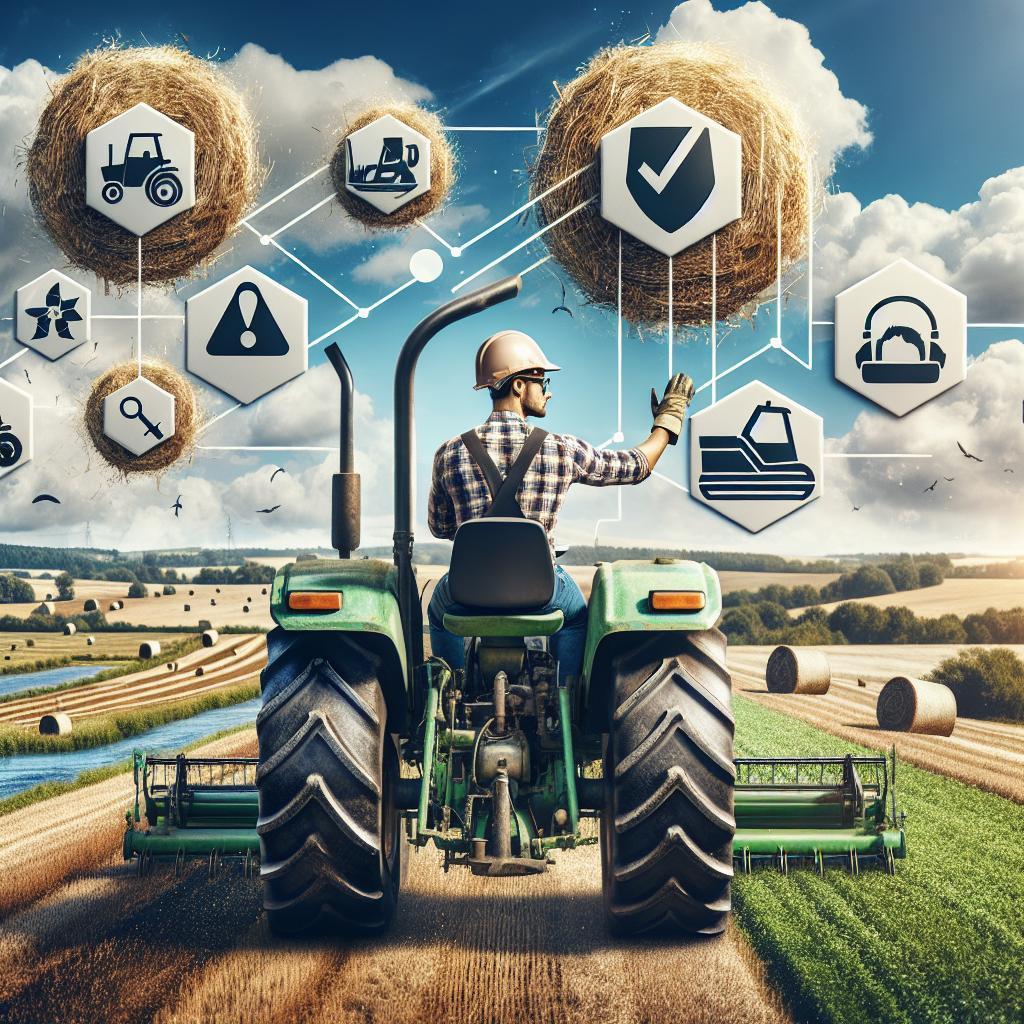This post may contain affiliate links which means I may receive a commission for purchases made through links. Learn more on my Private Policy page.
Operating a hay rake can often be a dance between efficiency and safety on the bustling stage of a farm. As the sun rises and the fields are bathed in golden light, farmers prepare to harness the power of these essential machines to gather and aerate hay in preparation for bountiful harvests. However, like any powerful tool, hay rakes come with their own set of risks. While they are designed to make the chore of haymaking smoother and quicker, improper operation can lead to accidents and injuries. In this article, we will explore essential safety measures that every farmer should prioritize when using a hay rake. By fostering a culture of safety and awareness, you can ensure that your haymaking efforts are not only productive but also secure, allowing you to focus on what truly matters: the health of your land and the success of your farming endeavors. Join us as we unravel the key practices that will help you navigate the fields with confidence and care.
Essential Pre-Operation Checks for Maximum Safety
Ensuring the safety of both the operator and the machinery is paramount before starting any hay rake operation. Begin with a thorough inspection of the equipment, focusing on critical components that directly influence safety. Look for loose bolts, worn-out parts, and proper lubrication of moving parts to prevent unexpected malfunctions. Check the condition of the tines and belts; any signs of wear or damage could lead to accidents or reduced performance. Additionally, verify that all safety guards and shields are in place, as they provide essential protection against flying debris.
Before hitting the field, it’s essential to review safety protocols and make sure the operator is familiar with the hay rake’s operation manual. Conducting a pre-operation briefing can help in reinforcing safety awareness. Create a checklist that includes items such as personal protective equipment (PPE) readiness, the surrounding area for hazards, and fluid levels in the machinery. To keep track of these checks, consider the following table format that visualizes your pre-operation assessment:
| Pre-Operation Check | Status | Notes |
|---|---|---|
| Inspect safety guards | ✔️ | All intact and secure |
| Fluid levels checked | ✔️ | Oil and coolant adequate |
| Condition of tines | ✔️ | No visible damage |
| Personal protective equipment | ✔️ | Helmet, gloves, and goggles ready |

Navigating Terrain: Tips for Safe Hay Raking
Operating a hay rake requires more than just a firm grip on the steering wheel; it demands an acute awareness of the terrain you’re working on. Begin by conducting a thorough assessment of the field before you start. Look for uneven ground, potholes, and obstacles like rocks or logs that could cause not only damage to your equipment but also potential accidents. Maintain a safe distance from any fences, trees, or buildings, ensuring a clear path for movement. Additionally, adjust the height of the hay rake to minimize contact with the ground, which can help to prevent sudden jolts and give you better control.
Staying vigilant about environmental factors is equally important in ensuring safety during hay raking. Wet or muddy conditions can significantly affect traction, so it’s wise to monitor weather forecasts and avoid working in poor conditions. Pay attention to the visibility of your surroundings; be prepared to halt operations in the face of sudden changes such as a gathering storm or loss of daylight. Implementing a safety protocol for yourself and your crew can also go a long way. This could include basic safety gear like helmets, gloves, and sturdy boots, as well as regular breaks to reduce fatigue and maintain alertness.

Protective Gear: Equipping Yourself for Safety
When it comes to operating heavy machinery like a hay rake, protective gear is not just recommended—it’s essential. Ensuring that you are properly equipped can significantly reduce the risk of injury. Consider donning the following items each time you head out to the field:
- Hard Hat: Protects against head injuries from falling debris.
- Safety Goggles: Shields your eyes from dust, debris, and potential chemical splashes.
- Ear Protection: Reduces noise levels which can lead to hearing loss over time.
- Gloves: Provides grip and safeguards your hands from sharp edges and vibrations.
- Steel-Toed Boots: Prevents foot injuries from heavy machinery or tools.
In addition to personal protective equipment, ensuring your clothing is appropriate for the task can also enhance safety. Opt for high-visibility clothing so that you can be easily seen, especially in low-light conditions. Keep away loose-fitting garments that might get caught in moving machinery. Here’s a quick overview of some essential clothing items that contribute to a safer working environment:
| Clothing Item | Purpose |
|---|---|
| High-Visibility Vest | Enhances visibility in the field. |
| Durable Work Pants | Protects legs from abrasions and cuts. |
| Long-Sleeve Shirt | Offers protection from sunburn and sharp objects. |

Emergency Preparedness: Planning for the Unexpected
Operating a hay rake involves various hazards, underscoring the need for emergency preparedness measures on your farm. Regularly inspect your equipment to ensure it is in safe working condition—this includes checking for exposed wires, proper lubrication, and ensuring all guards are in place. Having a safety checklist can help keep track of these vital checks:
- Inspect connections: Ensure all hydraulic and electrical connections are secure.
- Check tire pressure: Regularly monitor tire condition and inflation levels.
- Wear protective gear: Always use gloves, goggles, and appropriate footwear.
Beyond equipment checks, it’s essential to have an emergency response plan that everyone on your farm is familiar with. This plan should outline the procedures for various emergencies, whether it’s an accident involving the hay rake, fire, or severe weather. Consider organizing regular training sessions to educate workers on the emergency protocols:
| Emergency Type | Response Procedure |
|---|---|
| Accident | Call for help, assess injuries, administer first aid. |
| Fire | Activate fire alarm, evacuate area, use extinguisher if safe. |
| Severe Weather | Seek shelter, monitor alerts, secure equipment. |
Q&A
Q: What is a hay rake, and why is it important in farming?
A: A hay rake is a crucial piece of agricultural equipment used to gather cut hay into windrows for drying. Its importance lies in its ability to streamline hay production, ensuring efficient drying and easier collection for baling. Operating it safely is key to maximizing efficiency while preventing accidents.
Q: What are the primary safety measures to consider before operating a hay rake?
A: Before hopping on the seat, it’s essential to conduct a pre-operation check. This includes inspecting the rake for any wear or damage, ensuring all safety guards are in place, and checking fluid levels. Additionally, ensure that the area is free from obstacles, bystanders, and pets—safety starts with a clear workspace!
Q: How can operators ensure their own safety while using a hay rake?
A: Safety gear is your best friend! Wearing appropriate clothing—like sturdy boots, gloves, and safety glasses—can help protect you from injury. Always be alert, as distractions while operating machinery can lead to accidents. It’s also wise to familiarize yourself with the rake’s controls before you start, as knowing your equipment can save you from mishaps.
Q: What should operators do in case of an emergency while operating a hay rake?
A: In the event of an emergency, such as a topple or equipment malfunction, it is crucial to immediately turn off the engine to stop all moving parts. Ensure you have access to a first aid kit and know the location of the nearest phone or emergency contact. Having a plan in place beforehand can make all the difference in effectively managing emergencies.
Q: What are some tips for safe operation while on uneven terrain?
A: Navigating uneven terrain can be challenging, so take it slow! Reduce your speed to maintain control and avoid tipping. Always be mindful of your surroundings, as hidden ditches or rocks can pose risks. If possible, use a tractor with proper ballast to enhance stability and keep your equipment level.
Q: Are there any particular weather conditions that can affect hay rake operation?
A: Absolutely! Wet or muddy conditions can make the ground slippery and increase the risk of losing traction or tipping. High winds can also affect the performance of the hay rake and its ability to collect hay properly. It’s wise to monitor weather forecasts and avoid operation in adverse conditions to protect both your equipment and your safety.
Q: What general farm safety practices apply when operating a hay rake?
A: Farm safety is a holistic approach! Always ensure that children and animals are kept at a safe distance when machinery is in operation. Proper communication with crew members is vital, especially when working in teams. Lastly, always keep an eye on your surroundings and be aware of other equipment and personnel nearby.
Q: Is training necessary for operating a hay rake, and if so, why?
A: Yes, training is crucial! Familiarity with the machine and its functions can significantly reduce the likelihood of accidents. Training can include hands-on experience, safety seminars, or even watching instructional videos. A well-trained operator not only enhances productivity but also fosters a culture of safety on the farm.
By following these essential safety measures, you can ensure a smoother and safer hay harvesting process, keeping both yourself and your farmland secure during operation. Happy farming!
Insights and Conclusions
the art of operating a hay rake safely requires a blend of knowledge, vigilance, and respect for the machinery at hand. By adhering to the essential safety measures outlined in this article, farmers can not only protect themselves but also foster a culture of safety on their farms. As you venture into the field, remember that every precaution taken mirrors your commitment to efficient farming practices and the well-being of everyone involved. So, gear up, stay alert, and let the rhythmic dance of your hay rake contribute to the harmony of your harvest. Happy raking, and may your bountiful fields remain safe and productive!
This post may contain affiliate links which means I may receive a commission for purchases made through links. Learn more on my Private Policy page.

